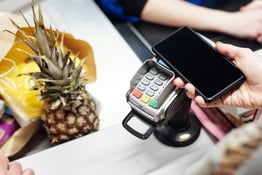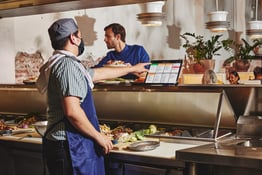If there’s one thing people prefer to dining out, it might just be dining in. For obvious reasons, Americans ordered an unfathomable amount of restaurant delivery in 2020. There’s some debate now as to whether the growth spurt will last for that hotly contested corner of the industry. But more than ever — because of the size of the industry, its costs, consumer habits, and the rise of ghost kitchens — most restaurant operators across the country must at least weigh delivery as a component of their business.
Consider the tremendous year enjoyed by the likes of DoorDash (which also owns Caviar), Uber Eats, Grubhub (which also owns Seamless), and Postmates. DoorDash, which controls about 55 percent of the food delivery market, saw its users increase by 80 percent and its revenue more than triple to $2.9 billion. It wasn’t just food from around the corner that people were ordering. The delivery service Goldbelly, specializing in shipping restaurant meals across great distances at a tremendous markup, quadrupled its business last year and then raised $100 million in new funding. In the latest State of the Restaurant Industry survey, 68 percent of consumers said they were more likely to order delivery now than before the pandemic.
Your options are myriad, but there’s a core question when you’re starting out. Should you sign up with a company that specializes in delivery? Or run your own deliveries, rather than farming them out?
There are pros and cons to consider on both sides. Ultimately your decision will come down to how you balance factors such as costs, staffing, quality control, and marketing expenses.
You might decide your next step is finding out how to start your own delivery service. Or you could in fact get to the bottom of your own list of competing interests and decide delivery isn’t worth it. Many restaurants operate without delivery, as it happens, and many that adopted delivery during the desperate days of 2020 are phasing it out. For starters, though, let’s figure out how to meet your customers where they are: chilling at home, doodling on their phone, hungry.
How do third-party food delivery services work?
The top third-party delivery platforms these days are built to be easy to use, wide in reach, and exceedingly convenient for customers and restaurant staff alike. The best third-party delivery service for you will vary on your needs, its coverage, and your geographical area. But the basic premise is that you sign onto a powerful marketing and operations platform, and they plug you directly into a ton of customers.
Once you as the restaurant sign up for the service, the advantages are numerous — these companies rake in billions of dollars for a reason. You don’t have to hire or train delivery drivers. You don’t need to build a website or an app to reach your customers. (And by extension, you don’t need to advertise your website or your app.) You’re able to plug-and-play on the same day you sign up. Customers will find you online immediately for take-out or for delivery, for immediate business. Your staff doesn’t have to take orders by phone. And if something goes wrong, the customer service teams at a big delivery company are built to handle the situation, taking even more pressure off your staff.
The biggest downside you probably already know: The convenience comes at a high price. Commissions on a DoorDash or Uber or Grubhub order can reach 20 or 30 percent, in some cases completely wiping out the margin you would’ve made. You’ll have to keep checking your receipts, as you could be charged for services like customers calling your restaurant through the app — even if they don’t place an order. If you want to get down in the weeds, see how one New York restaurant loses almost $3 every time it has to deliver a $15 sandwich.
In 2020, as restaurants were struggling to survive, the fee structures went from being merely contentious to a full-blown political issue. During the pandemic cities such as New York and San Francisco capped commission fees. The threat of regulation has nudged the companies to offer different pricing structures, including a few that don’t require the commissions (which are, in effect, you paying for marketing, not for delivery itself). It’s worth scrutinizing the fee structure intensely before you sign up for a delivery service. The only thing worse than having no one walk in the door might be working like mad just to send money out the door with every delivery.
There can be such a thing as too much business, especially if it’s on your thinnest-margin orders. Busy restaurants that take on a ton of delivery orders might have a pack of delivery drivers or cyclists hovering outside at all hours, a possible deterrent for customers arriving to dine in. And your staff workflow will have to accommodate the high volume. Don’t put yourself in a position where you’re doing a lot more work for not much more cheddar.
The other drawback you might find is that when you hire a third-party service, your delivery person in effect works for someone else. But if that person screws up a delivery, or even gets stuck in traffic, an irate customer will be leaving a review for your restaurant, not for a massive delivery service. It’s simply out of your hands, which isn’t always a great feeling for restaurant owners who spend their working lives trying to build a great experience for their customers.
Why start your own delivery service?
In a word? Control. You control your own costs, you control your staffing, and you control your data, which third-party delivery platforms don’t always offer to client. That means you can build your own direct relationship with your customers, their interactions with your staff, and your communications to them.
Customers also prefer the idea, for what it’s worth. The State of the Restaurant Industry 2021 found 64 percent said they’d rather order directly from a restaurant, compared with 18 percent who preferred a third-party service (and another 18 percent who didn’t care). What people say and what they actually do might diverge, of course, but a nearly 4-to-1 preference is worth noting.
One possible workaround for the high costs is to use a platform that works on a subscription, rather than commission, fee structure. Your expenses for filling take-out orders will be much lower, and you’ll get to control your own destiny on delivery orders. ChowNow, for one, offers this model, giving you the digital infrastructure to run your own deliveries at a price that doesn’t increase with your volume of orders. (Instead, you may have a flat fee that you pass along to delivery customers.)
You can go as old-school as you want, on accepting orders. But realistically you at least will need a website (an app can be great, and one might be included in whatever package you buy for your website, but it’s probably not a necessity). These days your POS is well aware that many restaurants would prefer to avoid the expense of a third-party delivery service, so they’re making it increasingly simple to set up your own delivery on their platforms: Toast, Revel, Upserve, Lightspeed all have you covered there. The mobile platform Bentobox, same deal. Bottom line, if you’re setting up your own delivery, you won’t have to build it from scratch.
Now, the hard part: Making deliveries! You’ll have to hire a delivery person, or at least task someone on staff with making them. Figure out your delivery radius, and be realistic about how long your people will need to get back to your shop. If an order comes in the moment they hop on their bike to make a delivery, can they get back in time to deliver the next order while it’s hot? If your person is traveling by car, you’re probably covering gas, possibly insurance, possibly parking, possibly parking tickets.
One bright side of the rise of huge delivery services, though, is that customers are prepared for delivery fees in a way they might not have been even a few years ago. So as you set your own fee structure, you can customize it to your needs. Which is to say, you can build them to make sure you’re making money on your orders. And if you’re not? You’re not locked into a contract, so you can change your radius or drop delivery altogether if it’s simply not working out. Let customers know you’ll be happy to feed them at your restaurant. They might even decide to make a night of it.
[Photo by Rowan Freeman on Unsplash]





